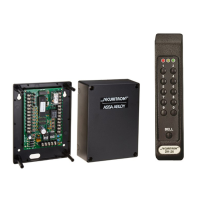
Do you have a question about the Assa Abloy Securitron DK-26 and is the answer not in the manual?
| Weather Resistant | Yes |
|---|---|
| Code Length | 4-6 digits |
| Backlighting | Yes |
| Compliance | UL 294 |
| Type | Digital Keypad |
| Power Supply | 12-24 VDC |
| Output | SPDT Relay |
| Mounting | Surface |
| Dimensions | 4.5" x 2.75" x 0.75" (114 mm x 70 mm x 19 mm) |
Details on mounting the keypad, drilling holes, and routing the cable.
Information on CPU board enclosure, mounting, and cable entry methods.
Specifies voltage range (12-24V AC/DC) and power consumption of the DK-26.
Instructions for connecting the 12-wire keypad cable to the CPU board terminals.
Overview of different wiring schemes for electric lock control based on lock type.
Wiring for fail-secure AC locks using an AC transformer and the DK-26 relay.
Diagram showing CPU board layout, keypad cable connections, and relay functions.
Wiring DC electric locks using an AC transformer and the DK-26 CPU board's DC output.
Details on installing the MOV to absorb inductive kickback from lock coils.
Wiring DC electric locks using a DC power supply and the DK-26 CPU board.
Explains uses of the 'F' terminal for wire termination or fire alarm interface.
Connecting external switches for lock control, excluding REX function.
Connecting switches for timed door release from inside the protected area.
Wiring diagrams for adding external contacts for fail-safe and fail-secure locks.
Details on how the REX input works, including retriggering and extended release.
Wiring for fail-safe locks using double break switches for reliable egress.
Setup for a single, rarely changed code for lower security applications.
Step-by-step guide to programming the initial 'Hard code' for fixed operation.
Procedure to erase all programmed codes if the unit does not start with a blank state.
Setup for using a Program code to change the User code from the keypad.
Procedure to erase existing codes using the Program code and specific prefixes.
Step-by-step guide for setting Program and User codes for keypad changeable programming.
Daily procedure for end-users to change their User code via the keypad.
Instructions for adding up to 59 individual or group User codes.
Using the Hard code for universal access across multiple DK-26 units.
Explanation of how subset codes and duplicates are handled and rejected.
Procedures for deleting the Hard code, Program code, or individual User codes.
Procedure to erase all User codes using a special prefix, useful for resetting.
Configuring lock release time (1-99s) or toggle mode operation.
Customizing beeper sounds and LED logic for door release and programming.
Configuring the programmable relay to activate when the Bell key is pressed.
Using the Hard code to release the door and trigger a silent alarm.
Assigning the programmable relay to signal when 16 wrong digits are entered.
Using the programmable relay to signal if the door is left open too long.
Activating the programmable relay for five seconds when any key is pressed.
Connecting two keypads to a single CPU board for dual-sided door control.
Using switches to disable Hard code or all User codes, often for day/night operations.
Using the second relay pole to shunt an alarm system when the DK-26 opens the door.
Ensuring the lock resecures immediately upon door reclosure to prevent tailgating.
Assigning HCD/UCD terminals for anti-tailgating or door prop alarm functions.
Configuration for integrating the DK-26 with Securitron Touch Sense Bar and Magnalock.
Steps to diagnose and resolve issues when the unit shows no power or activity.
Diagnosing and resetting PolySwitches (#1, #2, #3) for overload protection.
Specific causes and resolutions for PolySwitch trips related to AC power or DC lock operation.
Diagnosing issues where keys are stuck or not being read correctly.
Identifying and resolving issues where a specific key press is not registered.
Common programming errors, misunderstandings, and how to resolve them.
Resolving unintended door openings due to incorrect programming sequences.
Testing individual keypad keys using a voltmeter and terminal matrix.
Addressing issues like forgotten codes, erratic beepers, or timer variations due to noise.
